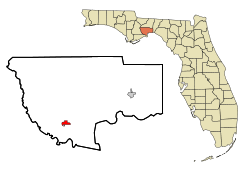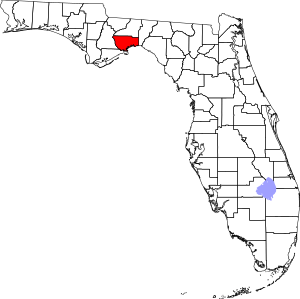Sopchoppy, Florida
Sopchoppy is a city in Wakulla County, Florida, United States. It is part of the Tallahassee, Florida Metropolitan Statistical Area. The population was 457 at the 2010 census. As of 2018, the population was estimated by the U.S. Census Bureau to be 482.[5] Ochlockonee River State Park is nearby.
Sopchoppy, Florida | |
|---|---|
 Location in Wakulla County and the state of Florida | |
| Coordinates: 30°3′36″N 84°29′28″W | |
| Country | |
| State | |
| County | Wakulla |
| Area | |
| • Total | 1.68 sq mi (4.35 km2) |
| • Land | 1.68 sq mi (4.35 km2) |
| • Water | 0.00 sq mi (0.00 km2) |
| Elevation | 30 ft (9 m) |
| Population (2010) | |
| • Total | 457 |
| • Estimate (2019)[2] | 492 |
| • Density | 293.21/sq mi (113.19/km2) |
| Time zone | UTC-5 (Eastern (EST)) |
| • Summer (DST) | UTC-4 (EDT) |
| ZIP code | 32358 |
| Area code(s) | 850 |
| FIPS code | 12-66925[3] |
| GNIS feature ID | 0306416[4] |
| Website | www |
Geography
Sopchoppy is located at 30°3′36″N 84°29′28″W (30.059994, -84.491084).[6]
According to the United States Census Bureau, the city has a total area of 1.5 square miles (3.9 km2.), all land.
History
The town's name is a corruption of "Lockchoppe", derived from the Muskogee lokchapi (lokcha (acorn) / api (stem)), which was the old name of the nearby river.[7]
Sopchoppy came into existence in 1894 after the CT&G Railroad Company built a railway through the area. It platted the town on property it already owned in the area, across the river from Greenough. To encourage people to settle the area, the railroad engaged in an advertising campaign, exaggerating the quality of the soil and climate.[8]
The Sopchoppy Depot was built in 1891. Now a museum, it was built for the Carrabelle, Tallahassee & Georgia Railroad (G. F. & A.), and referred to colloquially as the Gopher, Frog & Alligator, Company, which was absorbed by the Georgia, Florida and Alabama Railroad. The line began in 1893 and closed in 1946. It transported lumber, turpentine and related products, honey, farm produce, soldiers, fish and oysters packed in barrels in ice as well as sturgeon caviar from the Sopchoppy River, frog legs, and catfish.[9]
Festivals
The town is home to the annual Worm Grunting Festival, a town celebration named in honor of a worm grunting — also known as worm charming — a method for driving worms to the surface of the earth. Worm charmers hammer wooden stakes into the ground, then rub them with metal slabs. The resulting vibrations cause worms to surface, whereupon they are typically gathered and used or sold for fishing bait.[10]
Part of Tim Dorsey's 2017 novel Clownfish Blues is set in Sopchoppy and worm grunting is a plot element.
Demographics
| Historical population | |||
|---|---|---|---|
| Census | Pop. | %± | |
| 1960 | 450 | — | |
| 1970 | 460 | 2.2% | |
| 1980 | 444 | −3.5% | |
| 1990 | 367 | −17.3% | |
| 2000 | 426 | 16.1% | |
| 2010 | 457 | 7.3% | |
| Est. 2019 | 492 | [2] | 7.7% |
| U.S. Decennial Census[11] | |||
As of the 2000 census,[3] there were 426 people, 178 households, and 111 families residing in the city. The population density was 280.4 people per square mile (108.2/km2). There were 216 housing units at an average density of 142.2 per square mile (54.9/km2). The racial makeup of the city was 78.40% White, 18.08% African American, 1.17% Native American, 0.70% Asian, 1.17% from other races, and 0.47% from two or more races. Hispanic or Latino of any race were 3.99% of the population.
There were 178 households, out of which 32.0% had children under the age of 18 living with them, 43.8% were married couples living together, 15.2% had a female householder with no husband present, and 37.6% were non-families. 32.6% of all households were made up of individuals, and 11.2% had someone living alone who was 65 years of age or older. The average household size was 2.39 and the average family size was 3.09.
In the city, the population was spread out, with 26.8% under the age of 18, 8.2% from 18 to 24, 29.1% from 25 to 44, 22.5% from 45 to 64, and 13.4% who were 65 years of age or older. The median age was 38 years. For every 100 females, there were 86.0 males. For every 100 females age 18 and over, there were 80.3 males.
The median income for a household in the city was $29,583, and the median income for a family was $33,750. Males had a median income of $30,833 versus $17,188 for females. The per capita income for the city was $14,165. About 14.4% of families and 17.1% of the population were below the poverty line, including 11.9% of those under age 18 and 48.2% of those age 65 or over.
Notable residents
- B. K. Roberts, Florida Supreme Court Justice, was born in Sopchoppy.[12]
References
- "2019 U.S. Gazetteer Files". United States Census Bureau. Retrieved July 2, 2020.
- "Population and Housing Unit Estimates". United States Census Bureau. May 24, 2020. Retrieved May 27, 2020.
- "U.S. Census website". United States Census Bureau. Retrieved 2008-01-31.
- "US Board on Geographic Names". United States Geological Survey. 2007-10-25. Retrieved 2008-01-31.
- "Population and Housing Unit Estimates". Retrieved March 14, 2020.
- "US Gazetteer files: 2010, 2000, and 1990". United States Census Bureau. 2011-02-12. Retrieved 2011-04-23.
- "Name Origins of Florida Places @ Florida OCHP". www.flheritage.com.
- "The Sopchoppy River (Florida)". www.littletownmart.com.
- http://www.visitwakulla.com/Things-to-Do/Historic-Sopchoppy-Train-Depot
- "In The Spotlight: Worm Gruntin Festival". www.wctv.tv. Archived from the original on 2014-08-08.
- "Census of Population and Housing". Census.gov. Retrieved June 4, 2015.
- Basse, Craig (August 6, 1999). "Longtime Supreme Court Justice B.K. Roberts dies". Tampa Bay Times. Retrieved August 10, 2020.

